Path Spread
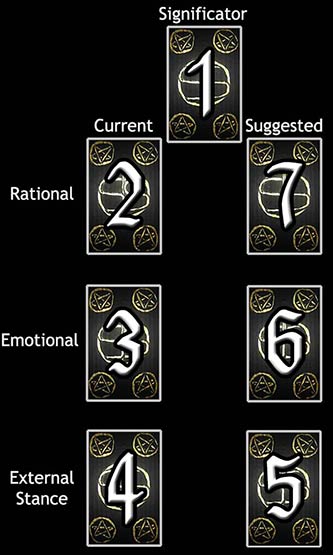
Difficulty: Easy
For the Path reading, one asks for suggestions how to behave properly to achieve a desired result. The Current column represents how the reader has been acting, and the Suggestedcolumn suggests how they should act to achieve a certain goal. The chart-like spread uses the standard three levels: Rational, Emotional, and External Stance (how one projects oneself outwardly). When comparing the Current and Suggested cards, the most important thing is to notice the differences between the two cards. It is these differences which hint at the behaviours that should be altered.
Card #1 is the significator, the card which should reflect the nature of the query and/or the desired outcome.
Card #2 shows the way the reader is and has been thinking. Card #7 suggests how to change the way one thinks to serve themselves better.
Card #3 suggests the reader's emotional attitude. Though it may seem difficult to manipulate one's own emotions, it can be done if one puts their mind to it. For example, acting a certain way such as smiling intently for a few minutes will lead the emotions to follow. When a person tries this, as silly as the exercise seems, they find this to evoke the emotion of happiness. For this reading, one should try to make themselves feel the way that Card #6 suggests.
External Stance means how one acts outwardly, how they hope others see them. Card #4 is about how the reader has been acting, while #5 indicates how they should act outwardly, for other people's sake. It is the differences between these cards that hint at what behaviour patterns should be altered.
Your Path Reading
| Current | The Significator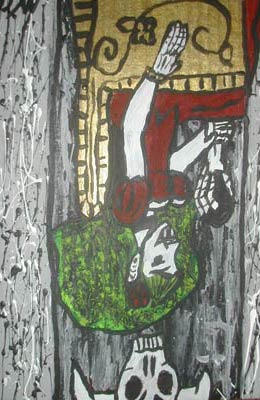 III. The Empress |
Suggested | |
| Thought | 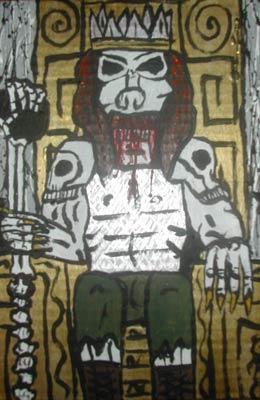 IV. The Emperor |
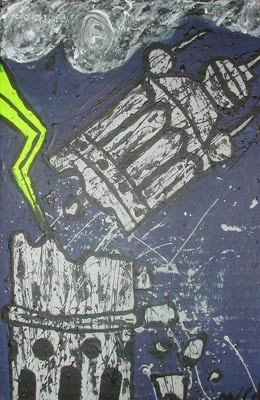 XVI. The Tower |
|
| Emotion | 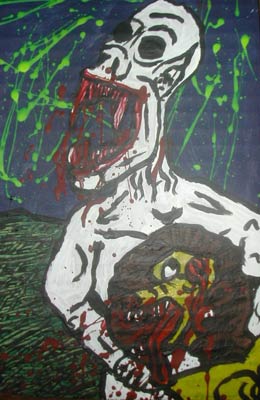 VIII. Strength |
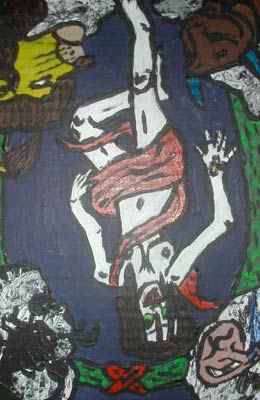 XXI. The World |
|
| External Stance | 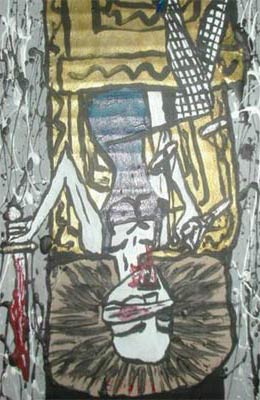 XI. Justice |
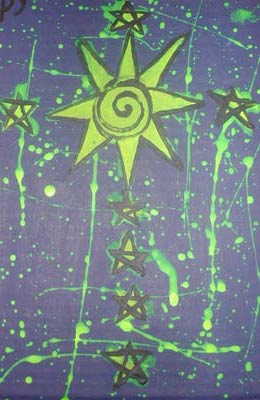 XVII. The Star |

The Significator
III. The Empress
Reversed
Symbolism:
The Empress sits upon her throne, her presence commanding yet nurturing. She holds the Hand of Glory, a macabre artifact symbolizing her power to claim whatever she desires. Her surroundings are lush and fertile, with dark roses blooming amidst the decay—symbols of beauty and abundance arising from even the grimmest conditions. Her expression is one of calm authority, radiating life-giving energy.
Meaning:
The Empress represents creation, fertility, and the nurturing aspects of life. She signifies abundance and the ability to bring ideas, projects, or relationships to fruition. This card invites you to connect with your creative or maternal instincts and embrace the cycles of growth and renewal. It may also point to emotional or physical abundance and a celebration of life's pleasures.
Reversed, the Empress warns of stagnation, overbearing tendencies, or emotional imbalance. It may point to neglect, smothering, or difficulties in manifesting creativity.
Keywords:
Reversed: Stagnation, neglect, overbearing, creative block, emotional imbalance.

Current Thoughts
IV. The Emperor
Symbolism:
The Emperor is a Nosferatu seated on a blood-soaked throne, gripping the Hand of Glory as his scepter of authority. His crimson cloak flows like a river of lifeblood, symbolizing his dominion over life and death. Behind him, a craggy fortress rises, representing stability and the structures of power. His stern, commanding gaze reinforces his role as a protector and enforcer of order.
Meaning:
The Emperor symbolizes authority, stability, and protection. He represents the need for structure and discipline to achieve goals and maintain order. As a figure of leadership, he encourages reason and conviction in decision-making. This card often indicates a time to take control of your environment or to rely on a strong, supportive figure for guidance.
Keywords:
Upright: Authority, stability, protection, leadership, discipline, order, reason.

Suggested Thoughts
XVI. The Tower
Symbolism:
The Tower is shown as a crumbling gothic spire, struck by lightning and engulfed in flames. Figures are seen falling from the heights, their faces contorted in shock and despair. The dark sky above swirls with storm clouds, while the ground below splits open, exposing molten lava. Amid the destruction, a single raven perches on the rubble, symbolizing the potential for renewal through upheaval.
Meaning:
The Tower represents sudden upheaval, revelation, and the breaking down of false structures. It signals a dramatic, often unexpected event that shakes the foundations of your life, forcing you to confront harsh truths. While challenging, this card ultimately clears the way for genuine growth and transformation.
Keywords:
Upright: Upheaval, revelation, chaos, destruction, truth, transformation, awakening.

Current Emotions
VIII. Strength
Symbolism:
Strength is portrayed as a vampiric figure gently taming a feral wolf under the light of a crescent moon. The figure's touch is both commanding and tender, symbolizing the balance of power and compassion. The wolf, once a creature of wild aggression, now gazes at its tamer with loyalty and calm. Around them, thorny vines twist, a reminder of the challenges inherent in mastering one's inner beasts.
Meaning:
Strength embodies courage, inner power, and the triumph of compassion over brute force. It urges you to face challenges with patience and resilience, relying on your inner calm to overcome fear and adversity. This card often signals the need to master emotions, demonstrating that true strength lies in self-control and grace.
Keywords:
Upright: Inner strength, courage, resilience, patience, self-control, compassion, calm.

Suggested Emotions
XXI. The World
Reversed
Symbolism:
The World depicts a powerful figure standing within a glowing circle of blood-red roses, symbolizing completion and unity. The four corners of the card feature elemental creatures: a bat, a wolf, a raven, and a serpent, representing balance and harmony among all forces. A starry night sky stretches infinitely behind the figure, while they hold a silver orb and a golden key, symbolizing mastery and fulfillment.
Meaning:
The World represents completion, fulfillment, and the achievement of long-term goals. It signifies harmony, wholeness, and the realization of your place in the greater tapestry of existence. This card often marks the end of a significant journey, celebrating your success and inviting you to share your gifts with others.
Reversed, the World suggests delays, unfinished business, or feelings of incompleteness. It may indicate the need to tie up loose ends before moving forward.
Keywords:
Reversed: Delays, lack of closure, incompletion, stagnation, unfinished business, imbalance.

Current External Stance
XI. Justice
Reversed
Symbolism:
Justice is depicted as a pale, vampiric figure holding a pair of scales in one hand and a blood-stained sword in the other. One side of the scale holds a black feather, while the other holds a human heart, symbolizing the balance between moral accountability and emotional truth. Her blindfold is sheer, hinting at impartiality tempered with insight. Behind her, a blood-red curtain reveals fragmented mirrors reflecting distorted truths.
Meaning:
Justice embodies fairness, truth, and accountability. She calls for honesty and objectivity in your actions and decisions, ensuring that you consider all perspectives before rendering judgment. This card often signals the need to weigh your choices carefully and to take responsibility for the consequences of past actions.
Reversed, Justice suggests imbalance, dishonesty, or unfair treatment. It may indicate a refusal to acknowledge the truth or an avoidance of accountability for your actions.
Keywords:
Reversed: Dishonesty, unfairness, imbalance, corruption, denial of truth, avoidance.

Suggested External Stance
XVII. The Star
Reversed
Symbolism:
The Star depicts a luminous vampire bathing in a moonlit pool, her pale skin shimmering with starlight. She pours blood from a goblet into the water, symbolizing renewal and the cycle of life. Above her, a constellation forms the shape of a chalice, representing hope and inspiration. The night sky is clear, and the surrounding landscape, though desolate, begins to show signs of new growth.
Meaning:
The Star embodies hope, inspiration, and spiritual renewal. It encourages you to trust in the universe and your own inner light, even during challenging times. This card often appears after a period of struggle, signaling healing, clarity, and the promise of brighter days ahead.
Reversed, the Star warns of doubt, pessimism, or a loss of direction. It may suggest the need to reconnect with your dreams or rekindle your faith in the future.
Keywords:
Reversed: Doubt, despair, loss of faith, disconnection, hopelessness, lack of direction.
